Welsh: Kincaled
Gringalet, Gringuljet, Gringuljete, Guincalet, Winwalite
Gawain’s magnificent horse, first mentioned by Chrétien de Troyes in Erec and Enide; D.D.R. Owen, in a note to line 3955 of that romance, remarks that the traditional name of Gawain’s horse is possibly derived either from Welsh ceincaled (“handsome-hardy”) or guin-calet (“white-hardy”), or gwyngalet (“white-hard”). The horse of Gwalchmei, Gawain’s counterpart in Welsh legend, is called Kincaled.

Wolfram von Eschenbach, who gives it the epithet “with the red ears”, says that it came from the Grail Castle of Munsalvaesche and was originally owned by the Grail Knight Lybbeals of Prienlascors. King Lähelin won the horse when he killed Lybbeals in a joust.
Lähelin gave the steed to his brother Duke Orilus who, in turn, gave it to Gawain. It was stolen by Urjans, won from him by Lischois Gwelljus, and returned to Gawain when he defeated Lischois.
Sir Kay coolly borrowed him on assumed premission, took a little gallop, and kept his seat until he attempted a joust with Erec. At still another time, Greoreas – who was any enemy of Gawain – stole it, but Gawain recovered it when he defeated Greoreas’ nephew.
The Vulgate Merlin names Gringolet’s first owner as the Saxon king Clarion, one of the many Saxon rulers who invaded Britain in the early days of Arthur’s reign. Gawain took Gringolet from Clarion after defeating him in a skirmish on the plains of Roestoc. Finally, in Girart D’Amiens’ Escanor, Gawain obtains the steed from Escanor Le Grand, who had recieved it as a gift from the fairy Esclarmonde. The animal would not eat or drink in the absence of its former master, until a maiden named Felinete helped Gawain cure Gringolet by removing a bag of powder from one of the horse’s ears.
The most memorable role so far found where Gringolet played a role in Chrétien’s Perceval. Sending his squires and other horses home from undertaking the quest of the Bleeding Lance, Gawain keeps Gringolet alone. At one point, near the Galloway border, he loses the steed to Greoreas, but subsequently recovers him from Greoreas’ nephew. Next day, challenged by the Haughty Maid of Logres to jump his horse across the Perilous Ford, Gawain achieves the crossing twice – but only thanks to Gringolet’s strength and dexterity. The first time the charger misses the farther bank and lands in the water, but swims until his four feet touch bottom, when he leaves himself and his rider to dry ground in one impressive leap up the extremely steep side. This little accident may cause Gawain to feel that he has not fully met the Haughty Maid’s challenge (even though the Guiromelant assures him that no other knight has ever attempted that crossing and lived), for his first attempt, because this second time he jumped from bank to bank perfectly.
Image credit
Artist: Unknown
Sources
Erec | Chrétien de Troyes, late 12th century
Perceval, or Le Conte del Graal | Chrétien de Troyes, late 12th century
Parzival | Wolfram von Eschenbach, 1200–1210
Vulgate Merlin | 1220-1235
Escanor | Girart D’Amiens, c. 1280
